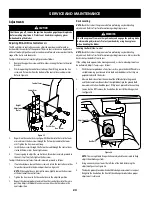
9
ASSEMBLY
Adjusting the Gauge Wheels
WARNING
Keep hands and feet away from the discharge opening of the cutting deck.
NOTE:
The deck gauge wheels are an anti-scalp feature of the deck and are not
designed to support the weight of the cutting deck.
The mower deck cutting height can be set in any of six height settings using the
riding mower’s deck lift handle. The deck heights range from 1-
1⁄
2” to 4”. The deck
gauge wheel position should be approximately
1⁄4
” to
1⁄
2” above the ground when
the deck is set in the desired height setting.
Using the lift handle, set the deck in the desired height setting, then check the
gauge wheel distance from the ground below. If necessary adjust as follows:
1.
Visually check the distance between the front gauge wheel and the ground.
If the gauge wheel is near or touching the ground, it should be raised. If
more than
1⁄
2” above the ground, it should be lowered.
2.
Remove the flange lock nut securing the gauge wheel shoulder bolt to the
deck. Remove the gauge wheel and shoulder bolt. Refer to “Figure 5”.
Lock Nut
Gauge Wheel
Shoulder Screw
Gauge Wheel Bracket Index Holes
Figure 5
3.
Insert the shoulder bolt into the one of four index holes in the gauge wheel
bracket that will give the gauge wheel a
1⁄4
” to
1⁄
2” clearance with the ground
and secure with the flange lock nut.
4.
Note the index hole of the just adjusted wheel, and adjust the other gauge
wheels into the respective index holes of the other gauge wheel brackets on
the deck.
Adjusting the Seat
NOTE:
Be sure to push the excess wire from the wire harness into the seat box hole
prior to lowering the seat.
To adjust the position of the seat, pivot the seat forward and locate the clamp knobs
on the front portion of the seat pan. Refer to “Figure 6”.
Figure 6
Rotate the clamp knobs to the left and remove them, slide the seat forward or
backward and re-insert the clamp knobs into one of the four available positions on
the seat pan and into the seat, then tighten securely. Make sure the seat is locked into
position before operating the tractor. See “Figure 6”
Gas and Oil
Fuel Recommendations
Use automotive gasoline (unleaded or low leaded to minimize combustion chamber
deposits) with a minimum of 87 octane. Gasoline with up to 10% ethanol or 15%
MTBE (Methyl Tertiary Butyl Ether) can be used. Never use an oil/gasoline mixture
or dirty gasoline. Avoid getting dirt, dust, or water in the fuel tank. DO NOT use E85
gasoline.
•
Refuel in a well-ventilated area with the engine stopped. Do not smoke or
allow flames or sparks in the area where the engine is refueled or where
gasoline is stored.
•
Do not overfill the fuel tank. After refueling, make sure the tank cap is closed
properly and securely.
•
Be careful not to spill fuel when refueling. Spilled fuel or fuel vapor may ignite.
If any fuel is spilled, make sure the area is dry before starting the engine.
•
Avoid repeated or prolonged contact with skin or breathing of vapor.
Содержание 247.20411 SERIES
Страница 67: ...NOTAS 67 ...
Страница 68: ...NOTAS 68 ...










































